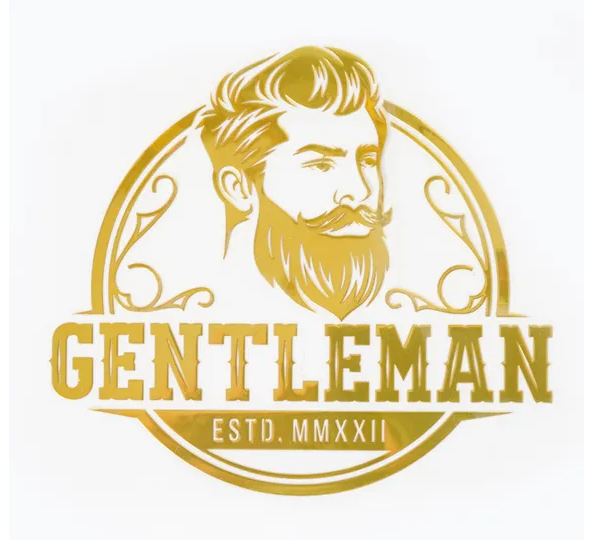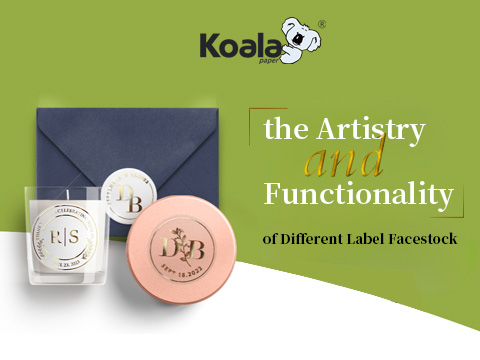Label plays a crucial role in various industries by capturing attention and conveying essential information.Label facestock refers to the material used as the base for labels. It is a vital component in label manufacturing. It provides the foundation for printing and protects the label’s design and content. Common materials used for label facestock include paper, film, and specialty materials.
Paper Facestock

Paper facestock is widely chosen for label production due to its versatility and cost-effectiveness. There are different types of paper used as facestock, including coated, uncoated, and textured papers, each offering unique characteristics and benefits.
Coated papers have a smooth surface that enhances the print quality and allows for vibrant and sharp colors. The coating provides a barrier that prevents ink absorption, resulting in excellent color reproduction and image clarity. Labels made with coated paper facestock are commonly used for product labeling, packaging, and promotional materials where a visually appealing and professional look is desired. The smoothness of coated papers also facilitates easy application and ensures good adhesion to various surfaces.
Uncoated papers, on the other hand, provide a more natural and tactile feel. They have a porous surface that allows ink to penetrate, resulting in a softer and more organic appearance. Uncoated paper facestock is often chosen for labels that require a more rustic, handmade, or eco-friendly aesthetic. These labels are commonly used in industries such as gourmet food, craft beverages, and natural products, where a natural and authentic look is preferred.
Textured papers bring a touch of uniqueness and visual interest to labels. They have embossed patterns or textures that add depth and character to the label design. Textured paper facestock offers a tactile experience, allowing customers to feel and appreciate the label’s texture. Labels made with textured paper facestock are often used for luxury products, high-end packaging, and special occasions where creating a premium and sophisticated impression is essential.
Paper facestock is suitable for a wide range of applications. It can be found in industries such as cosmetics, food and beverage, health and wellness, and retail. Whether it’s for product labels, packaging, or promotional materials, paper facestock provides a cost-effective solution without compromising on visual appeal and print quality.
Overall, paper facestock offers versatility, affordability, and various aesthetic options. By selecting the appropriate type of paper, businesses can create labels that align with their brand image, enhance product presentation, and effectively communicate information to consumers.
Film Facestock

Film facestock provides a range of distinct advantages compared to paper, making it a preferred choice for many labeling applications. Films such as polyester, polypropylene, and vinyl are commonly used as facestock materials, each offering unique properties and benefits.
One of the key advantages of film facestock is its exceptional durability. Films are highly resistant to tearing, abrasion, and punctures, making them ideal for labels that need to withstand rigorous handling or challenging environments. Whether exposed to harsh weather conditions, extreme temperatures, or rough handling during transportation, film labels maintain their integrity and legibility, ensuring long-lasting performance.
Moisture resistance is another significant advantage of film facestock. Films are inherently resistant to water and moisture, protecting the label from smudging, smearing, or deterioration. This makes film labels suitable for products exposed to humid conditions, refrigeration, or moisture-rich environments.
Film facestock also offers excellent clarity, making it a preferred choice for transparent or see-through labels. Films provide a crystal-clear base that allows the label’s content to be showcased without distortion. This is particularly advantageous for applications where showcasing the product or its contents is essential, such as in the food and beverage, cosmetics, and personal care industries.
Film labels find extensive use in outdoor applications, thanks to their ability to withstand UV exposure and harsh environmental conditions. The inherent UV resistance of films prevents fading or discoloration, ensuring that labels remain visually appealing and legible even after prolonged exposure to sunlight. Industries such as automotive, outdoor equipment, and construction rely on film facestock for durable and weather-resistant labels.
Additionally, film facestock offers excellent printability, allowing for high-resolution graphics, intricate designs, and vibrant colors. Films have a smooth surface that facilitates precise and detailed printing, ensuring sharp text and graphics. This makes film labels an excellent choice for product branding, where visual impact and brand consistency are crucial.
Overall, film facestock provides durability, moisture resistance, UV resistance, and excellent printability. Its versatility and ability to withstand harsh conditions make it suitable for various industries, including automotive, electronics, industrial, and outdoor applications. Whether it’s for product identification, branding, or safety labeling, film facestock ensures long-lasting performance and visual appeal.
Specialty Facestock

Specialty facestock materials open up a world of artistic possibilities, allowing labels to stand out with unique visual effects and textures. These materials, including metallic, holographic, and textured facestock, offer a touch of artistry and exclusivity to labels, making them ideal for high-end products, luxury packaging, and limited-edition items.
Metallic facestock, often made from materials like foil or metalized films, creates a luxurious and eye-catching appearance. The metallic finish reflects light, giving labels a shimmering, elegant, and premium look. Labels with metallic facestock are commonly used for high-value products, such as cosmetics, spirits, and specialty food items, where the goal is to convey a sense of sophistication and exclusivity.
Holographic facestock offers a dynamic and captivating visual effect that instantly grabs attention. These facestock materials have a prismatic or iridescent surface that creates a mesmerizing play of colors and patterns as light hits them from different angles. Holographic labels stand out on the shelf, capturing the consumer’s curiosity and enhancing brand recognition. They are particularly popular in industries such as beverages, fashion, and entertainment, where creating a visually striking and memorable presence is crucial.
Textured facestock provides a tactile experience, adding depth and dimension to labels. These materials have embossed patterns, raised textures, or unique surfaces that can be felt by touch. Textured labels create a sensory connection with consumers, enhancing the overall label experience. The tactile nature of textured facestock is especially valuable for luxury packaging, high-end cosmetics, and premium beverages, where the goal is to engage multiple senses and evoke a sense of exclusivity.
Specialty facestock materials enable brands to differentiate themselves, create a strong visual impact, and enhance the perceived value of their products. By incorporating metallic, holographic, or textured elements into labels, companies can elevate their packaging, attract attention, and leave a lasting impression on consumers.
These specialty facestock options provide endless creative possibilities for label designers and brand managers. The choice of facestock material depends on the desired aesthetic, target audience, and brand positioning. Whether it’s the luxurious metallic finish, the captivating holographic effect, or the engaging tactile experience, specialty facestock materials offer a unique opportunity to make labels truly stand out in the market.
Considerations in Choosing Label Facestock
When selecting label facestock, several factors should be considered. These include durability requirements, adhesive compatibility, printability, and environmental considerations. Labels intended for long-term outdoor use may require highly durable facestock materials, while labels for indoor applications may prioritize print quality and cost-effectiveness.
Conclusion
Label facestock plays a vital role in the artistry and functionality of labels. Whether it’s the versatility of paper, the durability of film, or the uniqueness of specialty materials, the choice of facestock impacts the label’s visual appeal and performance. By carefully considering the specific requirements of each application, businesses can create labels that capture attention, convey information effectively, and enhance their brand image.
